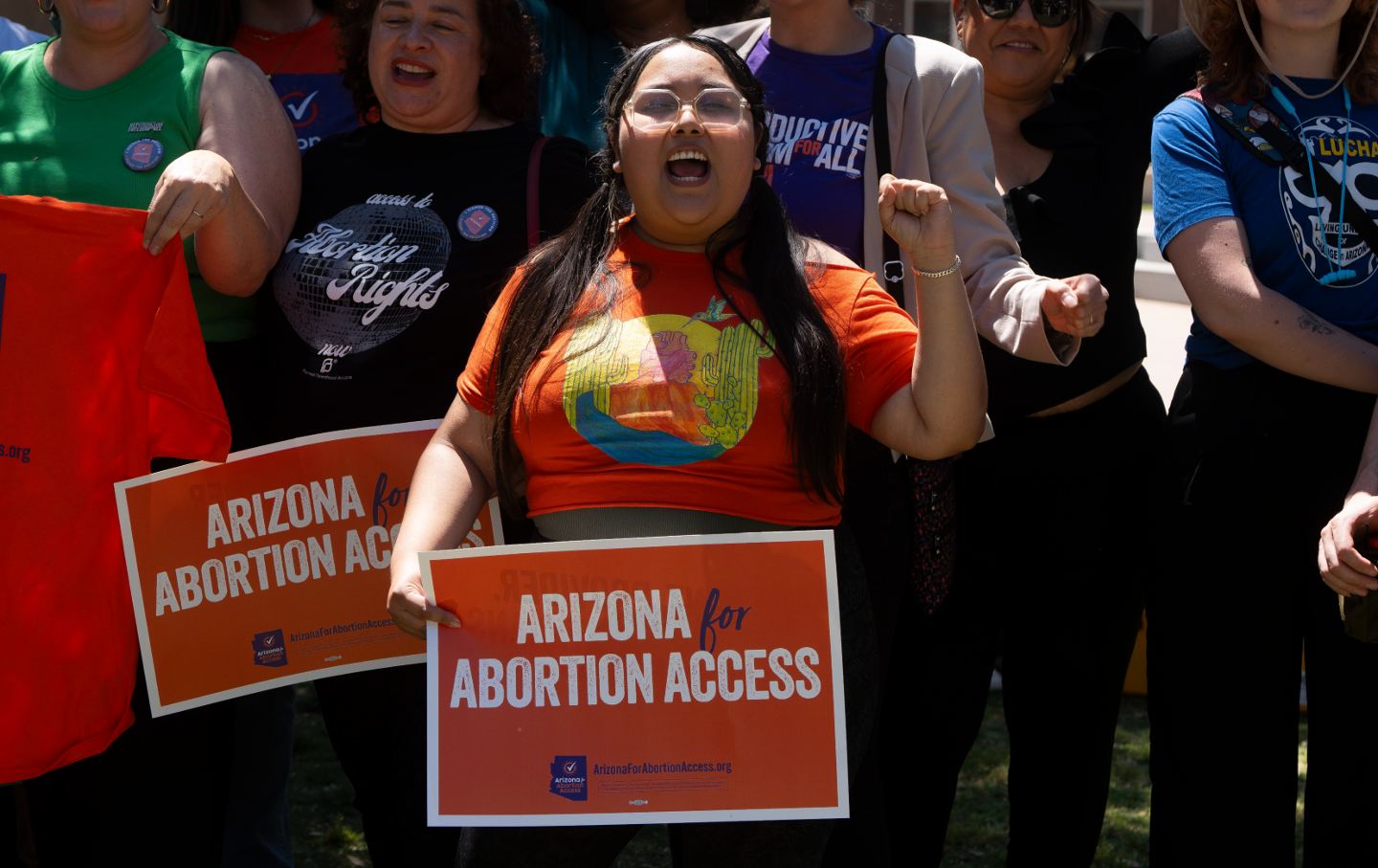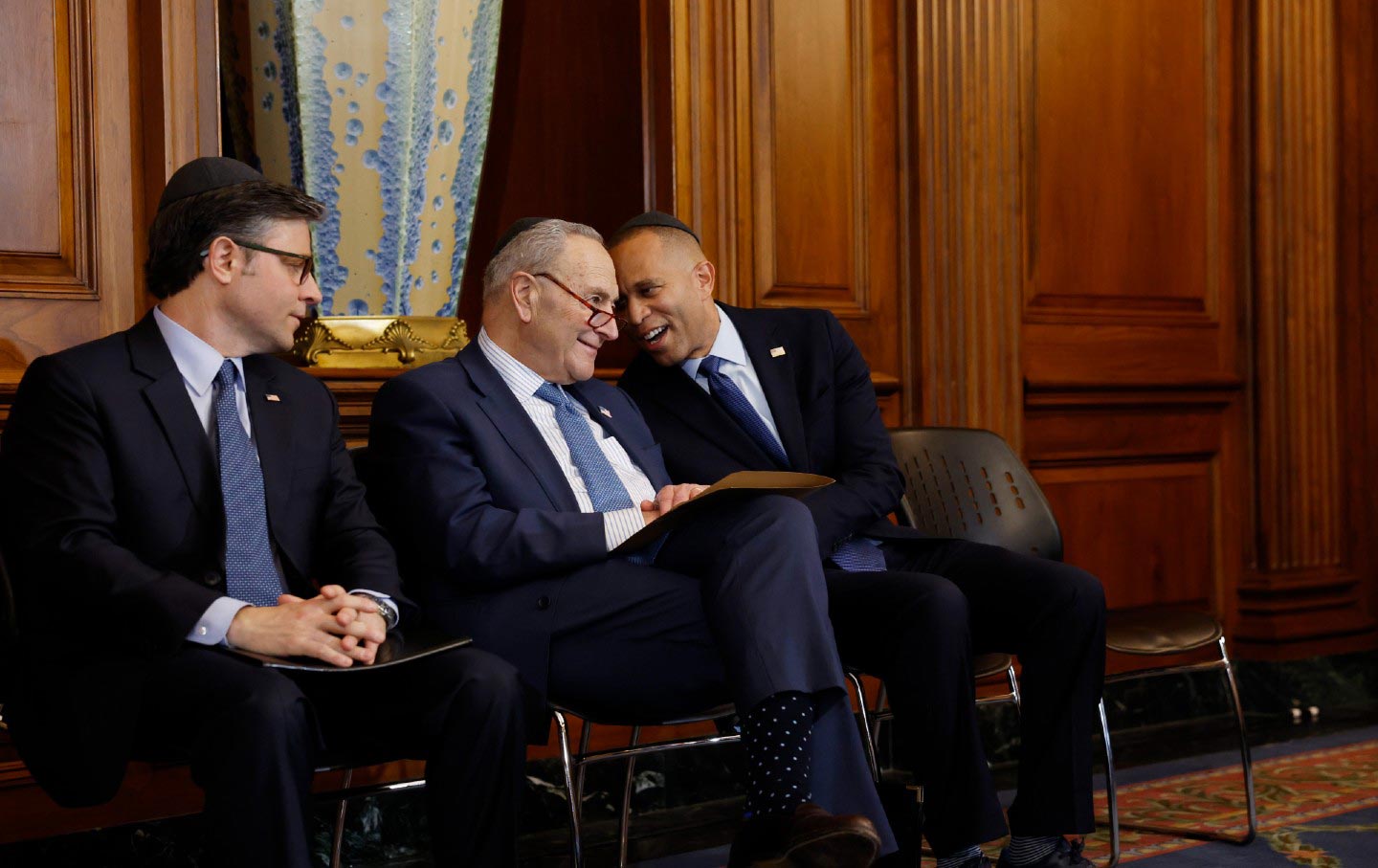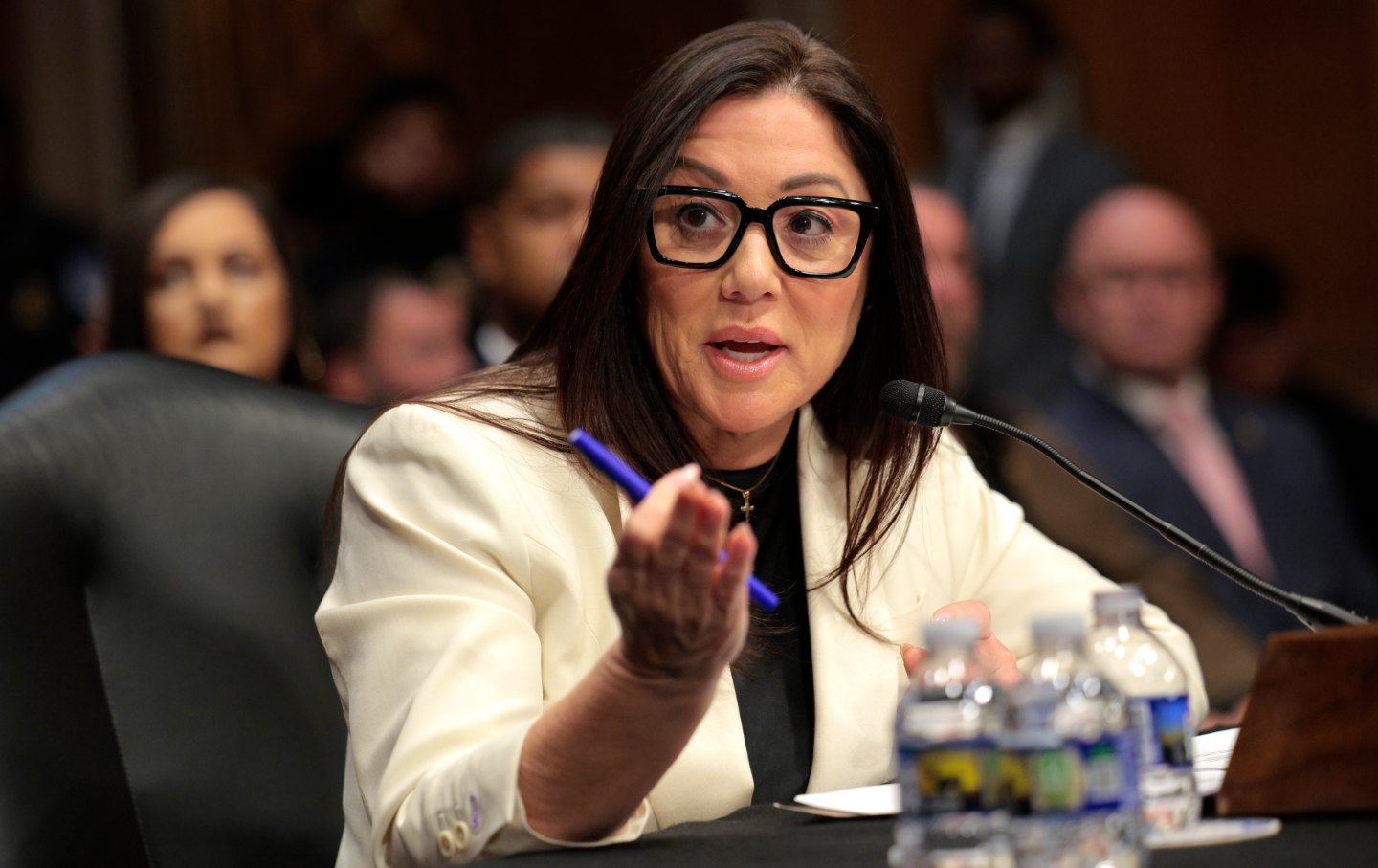Abortion Wins at the Ballot Box, Again—but Republicans Do Too
Voters in seven states restored, protected, or expanded the right to abortion care in their state. Many of them also voted for the man who ended Roe v. Wade.

After Roe was overturned, the Arizona Supreme Court revived an 1864 ban on abortion in the state. Now Arizonans have passed a ballot initiative to return abortion rights to the state.
(Rebecca Noble / Getty Images)
On Election Day 2024, voters in a record 10 states weighed in on ballot measures that would restore and protect abortion access. After the last polls closed and the final votes were counted, seven of the 10 states passed those measures—despite a “red wave” of voters who overwhelmingly selected former president Donald Trump as the next president of the United States, the candidate who boasts about “killing” Roe v. Wade and has floated his support for a nationwide abortion ban.
Voters in Arizona, Colorado, Maryland, Missouri, Montana, Nevada, and New York successfully restored, protected or expanded the right to abortion care in their respective states. In Missouri—the first state to ban abortion after the Dobbs decision—voters established a state constitutional right to an abortion until fetal viability. In Colorado and Maryland, voters successfully enshrined the right to an abortion with no gestational limit.
Three states—Florida, Nebraska, and South Dakota—failed to expand and protect abortion access. In Florida, the ballot measure had to surpass a 60 percent threshold rather than the usual 50 percent. In Nebraska, voters weighed in on two conflicting abortion measures—one that would enshrine abortion access until the point of fetal viability, and another that bans the procedure after the first trimester, which organizers argue confused voters.
Abortion ballot measures in nearly every state faced fierce opposition from the anti-abortion movement, including legal attempts to block the measures from appearing on ballots, threats made by state government agencies, and an influx of money from the so-called “pro-life” lobby—a powerful coalition of anti-abortion organizations that spends millions of dollars a year to curtail abortion rights—on counter-ads and disinformation campaigns.
Still, abortion overwhelmingly prevailed on Election Day, continuing the post-Roe trend of states stepping up to protect abortion access in the wake of the Dobbs decision that left more than one in three women—an estimated 23 million people—living in a state with an abortion ban. As political talking heads and pundits pontificate on the reasons for Trump and the Republican Party’s sweeping 2024 election victory—and the Democrats’ resounding defeat—one thing is for certain: Abortion is a winning, bipartisan issue.
Arizona
A reported 61.4 percent of Arizonans voted “yes” on Proposition 139, successfully nullifying the state’s current 15-week abortion ban by amending the state’s Constitution to establish a fundamental right to abortion care with no government interference to the point of fetal viability (generally considered around 24 weeks’ gestation).
The proposition was the result of what is referred to as “direct democracy”—where policy is determined by the people via citizen-initiated ballot measures—which less than half the states, largely in the West, have. “This type of campaign isn’t easy,” Laura Dent, campaign manager for Yes on 139, says. “You have to collect hundreds of thousands of signatures. But there was passion and enthusiasm behind this effort—it was incredible.” The Arizona Abortion Access Campaign, the pro–abortion rights organization behind the ballot initiative, filed 823,685 total signatures to qualify for the ballot—double the required 383,923 verified voter signatures needed.
According to Victoria Lopez, director of program and strategy at the ACLU of Arizona, the election results will now be certified and “then there will be a proclamation by the governor, because we’re dealing with a constitutional amendment to the Arizona State Constitution.”
“We’re all going to benefit from this protection passing and being codified into our state’s Constitution,” Dent adds. “And of course, the folks who are most impacted—folks of limited economic means, women of color, people who already have struggles and challenges accessing abortion care.”
Florida
While voters in Florida failed to pass Amendment 4, which would have struck down the state’s six-week abortion ban by enshrining the right to abortion care until fetal viability in the state Constitution, that’s not to say most voters did not support the measure. Only 42.9 percent of Floridians voted “no” on the measure, compared to the 57.1 percent who voted yes. The problem, however, is that in order to pass a constitutional amendment more than 60 percent of voters must agree to the measure.
Florida state constitutional amendments had a 50 percent threshold requirement until 2006, when voters approved a ballot measure that increased the requirement to 60 percent.
“Oddly enough, that constitutional amendment only passed by 57 percent, and not 60 percent,” Orlando Attorney Larry Walters told local new station FOX 35. Some Republican lawmakers in the state, including state Representative Randy Fine, would like to see an even higher threshold.
“I think it should be difficult to change Florida’s Constitution,” he told the same outlet. “Because once you change it, the only way you can fix it is to change it again. So I think it should be hard. I fundamentally don’t believe the appropriate use of the constitutional amendment process is to legislate.”
Nevada
A resounding 63.8 percent of the Nevada electorate voted “yes” on Question 6, amending the state Constitution by establishing a fundamental right to an abortion until fetal viability or when the pregnant person’s life is in danger. Currently, abortion is banned after 24 weeks’ gestation.
While the measure overwhelmingly passed, it is not yet Nevada law—voters will weigh in on the measure again in 2026, when it will appear on another general election ballot. In Nevada, state law requires all constitutional amendments to be approved in two even-numbered election years, meaning voters must pass the measure during a second vote on November 3, 2026, in order to officially enshrine abortion access in the Nevada state Constitution. If passed for a second time, it would solidify Nevada as another “safe haven” where abortion care prior to fetal viability could be obtained by people from neighboring states, including Idaho, which currently has a near-total abortion ban.
Colorado
Even before Tuesday’s election, Colorado was one of only nine states that does not restrict abortion based on gestational age. On Tuesday, 77 percent of residents voted “yes” on Amendment 79—well above the 55 percent threshold needed to pass.
The amendment adds language to the state Constitution establishing a right to abortion care and prohibiting any state or government government agency from impeding that right. The measure also lifted a 40-year ban on using government funds to pay for abortion procedures, making it much more accessible and affordable for those seeking to end an unwanted or nonviable pregnancy to receive abortion care services—a prohibition that was passed in 1984.
Missouri
Missouri—the first state to ban abortion after the Supreme Court overturned Roe v. Wade—overwhelmingly passed Amendment 3, striking down the state’s near-total abortion ban by establishing a constitutional right to abortion care until fetal viability.
The measure passed with 51.6 percent of the electoral vote, narrowly surpassing the 50 percent threshold. A reported 58.5 percent of the same electorate voted to elect Trump for president, as well handing GOP candidates victories in every statewide election, maintaining the Republican party’s majority in the Missouri General Assembly.
Montana
Ballot measure CI-128 passed with 57.2 percent of the vote, establishing a state constitutional right to abortion care and prohibiting the state government from punishing doctors who perform or patients who receive abortions.
Like Missouri, Montana voted in favor of the measure while also overwhelmingly voting for now President-elect Trump—the Republican candidate secured 58.9 percent of the vote while Vice President Kamala Harris won 38 percent.
“Young people stepped up and stood shoulder to shoulder with previous generations to protect our rights in the Montana constitution, including our right to make our own decisions about pregnancy and abortion,” Kiersten Iwai, executive director of Forward Montana, an organization behind the ballot initiative, said in a statement. “We will continue to make our voices heard on issues of critical importance to our state and our future.”
New York
Voters in New York protected an already established right to abortion care—up to fetal viability—by passing Proposition 1, amending the state Constitution prohibiting any state or local government from denying a person’s rights on the bases of their “ethnicity, national origin, age, disability” or “sex, including sexual orientation, gender identity, gender expression, pregnancy, pregnancy outcomes, and reproductive healthcare and autonomy.”
The amendment comes after a 20-year-old woman was reportedly in danger of facing criminal charges after she allegedly miscarried in a Manhattan restaurant. From June 24, 2022, to June 23, 2023, there have been at least 210 pregnancy-related prosecutions in the country—the majority of defendants were low-income women.
Now, local organizers are focused on passing a law that would eradicate the state’s fetal viability limits. Currently, abortion is banned after fetal viability with limited exceptions in the state.
“Gestational and viability limits are harmful and unjust, not supported by medical science or public health, and are not politically strategic or aligned with public opinion,” Erika Christensen, a reproductive justice advocate who had to travel out of New York State to obtain an abortion later in pregnancy, says. “Now is the time for all efforts to protect abortion to center those most impacted by abortion bans rather than cut them out. Now is the time for policies shaped by abortion seekers, abortion providers, and abortion funds, and aligned with the reproductive justice framework.”
Popular
“swipe left below to view more authors”Swipe →Nebraska
Nebraska was the only state that had two opposing abortion-related measures on the ballot. Voters struck down Initiative 439, with 51.3 percent of the electorate voting against the proposal that would have amended the state Constitution to establish a right to abortion care until fetal viability.
Instead, 55.3 percent of Nebraska residents voted in favor of Initiative 434, amending the state Constitution in order to prohibit abortion care in the second or third trimester except in cases of rape or incest or when the life of the pregnant person is in jeopardy. This means voters have essentially decided to keep the state’s 12-week abortion ban in place.
South Dakota
Amendment G, which would have reinstated Roe v. Wade–era abortion access and protections by enshrining the right to abortion care until viability in the state’s Constitution, failed in South Dakota. A reported 58.6 percent of voters said “no” to the measure, leaving in place the state’s total abortion ban with no exceptions for rape or incest.
Adam Weiland, cofounder of Dakotans for Health, the grassroots organization behind the measure, says they were simply out-funded by Right to Life and the powerful anti-abortion lobby, which according to the organization spent upwards of $3 million on a disinformation campaign.
“They were lies long ago disproven, yet shamelessly and endlessly repeated by Right to Life in false advertising paid for by a Connecticut dark-money group associated with Justice Clarence Thomas’s wife,” Weiland says. “They lied about parental consent, knowing full well that any medical procedure on a child, under long-established law, must be approved by a parent. They lied about ‘abortion up to birth,’ knowing full well that Amendment G explicitly says that [abortions later in pregnancy] may be prohibited.”
With zero outside financial help from national organizations like Planned Parenthood, Weiland says, the grassroots organization was essentially on its own. Now, the long-time political operative says it could be years until another abortion measure makes it to the ballot.
“It could be 20 years before something happens again,” he explains. “And it probably will be.”
Maryland
An overwhelming 74.1 percent of Maryland voters approved Question 1, a constitutional amendment that protects “the ability to make and effectuate decisions to prevent, continue, to end one’s own pregnancy.” Abortion access was already protected in the state with no gestational limit; however, the amendment—organizers hope—will prevent future government officials from attempting to curtail that right.
Some abortion rights advocates caution, however, that with an impending second Trump presidency and the very real threat of a nationwide abortion ban, these constitutional amendments will not protect abortion access as intended. For example, should Congress pass and Trump sign a nationwide abortion ban that establishes so-called “fetal personhood,” federal law would supersede state mandates, and abortion would be illegal in all cases regardless.
While the majority of these abortion ballot initiatives passed, some with significant margins, the fact that many of those same voters also chose Donald Trump to be the 47th president of the United States is a harrowing reminder of how powerful disinformation campaigns are and continue to be.
Since Roe v. Wade was overturned, Republicans—including Trump—have attempted to distance themselves from their own anti-abortion policies. The president-elect has notoriously flip-flopped on his support for a nationwide abortion ban, while giving vague answers to the questions about whether he would support bans on birth control. Since Project 2025 was made public and met with resounding opposition, Trump has attempted to distance himself from the right-wing manifesto that rejects the fact that abortion is healthcare, despite at least 140 people who previously worked for the soon-to-be second-term president having had a hand in its creation. Now, Trump allies—including those rumored to have a spot in his upcoming cabinet—are admitting postelection that Project 2025 is, in fact, the Trump administration’s agenda.
In September, Trump called Florida’s six-week abortion ban “a terrible mistake,” but would not say whether he voted for the measure to protect abortion access on Election Day. “Stop talking about that,” Trump snapped at a reporter, who asked not once but twice if he voted “yes” or “no” on the measure.
Sadly, the large swath of the 2024 electorate have made the same mistake voters made in 2016—thinking Trump won’t do what was once thought impossible, like overturning Roe v. Wade. That could usher in a nationwide abortion ban with the help of a likely Republican majority in both the House and the Senate.
More from The Nation

This Executive Order Reveals the Trump-Musk Endgame This Executive Order Reveals the Trump-Musk Endgame
A recent order aimed at destroying independent regulatory agencies isn’t just about taking control of the state—it’s a giant cash-grab in disguise.

Trump’s Plan Is to Flood the Zone With Garbage Trump’s Plan Is to Flood the Zone With Garbage
All if it is meant to disorient and overwhelm us. The question is: How are we to navigate all that excrement?

Trump Is Unpopular—and So Are the Do-Nothing Democrats Trump Is Unpopular—and So Are the Do-Nothing Democrats
The president is increasingly hated, but so is an opposition party that fails to oppose.

Trump’s Labor Secretary Pick Turns Out to Be Super Anti-Labor Trump’s Labor Secretary Pick Turns Out to Be Super Anti-Labor
Surprise, surprise: Former representative Lori Chavez-DeRemer supports anti-union “right to work” laws and rejects a national minimum-wage hike.




